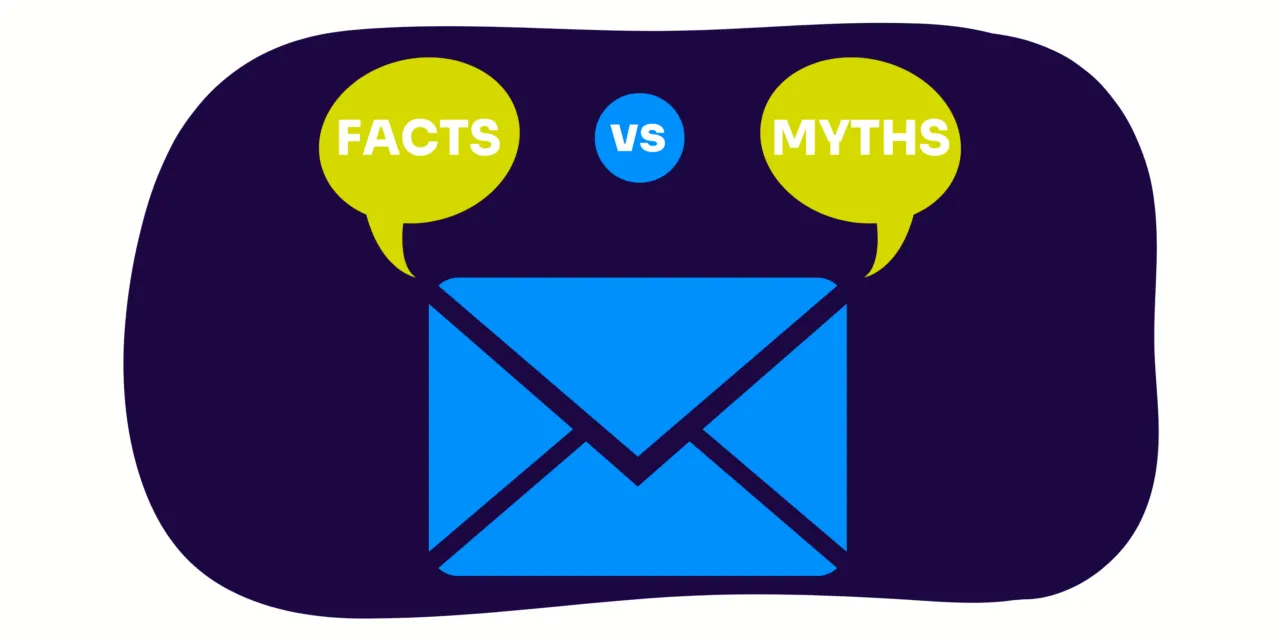6 Common Email Myths and How to Make it Work for Your Business
As a traditional form of communication, email has been the subject of multiple myths. And many say that email is dead and no longer effective in reaching and converting customers. In this blog, we'll debunk the most common email myths.

Many are rethinking the value of email, with new social media platforms like TikTok dominating the marketing plans and campaigns. Let’s pause for a minute and see how TikTok is reshaping marketing. According to at least one article, TikTok is the leader in in-app purchases in the United States, with over $700 million in-app store revenues in 2022. Also, the same report says that the platform exceeded $1 billion in global consumer spending through in-app purchases during the first quarter of 2023, the first app to achieve the feat.
Aside from TikTok, other social media platforms dominate marketing conversations, at least in attracting a huge chunk of the Gen Z market. With the buzz on TikTok and other social media platforms, many wonder if it’s time to leave email marketing behind.
So, should you leave email marketing for good? Well, not so fast. Did you know that email remains the second biggest marketing channel for small businesses, next to social media? It may be shocking to some, but email remains a potent marketing tool, and it delivers!
According to Litmus's research, email provides one of the best ROIs out there, and businesses can expect a return of $38 for every dollar spent on email marketing!
Another study from Creative Strategies tells us that email remains a choice productivity tool for employees 30 and older in collaborative work! As new sites and marketing tools are introduced, marketers and business owners often ask: Is email still an effective marketing tool when social media is used?
In this blog, we’ll revisit the power of email marketing. More importantly, we’ll debunk the common email myths, set the record straight, and offer guidance on maximizing email’s full potential.
But first, let’s revisit email marketing
Email marketing is a form of digital marketing that sends informational and promotional messages to targeted subscribers via email. This type of marketing isn’t just about sending readers announcements, promos, and notifications. Ultimately, email marketing aims to build and nurture relationships. There are different ways to email marketing, with newsletters, promotional offers, and product updates being the most popular.

Now that we’re all on the same page on email marketing, we’re ready to address the common myths.
#1 Email marketing is no longer relevant
Let’s start with the obvious—the source of much disinformation about email marketing. Email is not dead, and it’s still relevant and valuable to most marketers and business owners. We’ve already touched on the popularity of email among office workers who are 30 and over. A 2020 study of Creative Strategies found that email is the preferred collaborative working tool for this demographic, while workers under 30 prefer working with Zoom and Google Docs.
Other data say that 80% of businesses use email as part of their customer retention initiatives. Many companies still rely on email to engage and retain their customers.
#2 Gen Z and the younger audiences don’t use email
With the advent of TikTok and other vibrant social media platforms, many say the younger set no longer uses email. And we understand the concern of many when it comes to Gen Z and the younger audience since they have loads of buying power. You must include this demographic if you’re trying to boost the bottom line.
Although the younger set often enjoys their TikTok videos, it doesn’t mean they have ignored email. According to the Attest US Consumer Trend Report, over 50% of Gen Z read the weekly emails from their favorite brands, increasing to 66% for millennials. But this doesn’t mean sending emails automatically convinces your readers, and sales will happen. Email marketing takes a lot of work and requires knowing your audience.
#3 People no longer use and read emails
Most people see emails as a thing of the past, and people, regardless of age, no longer use and read them. We can’t fault some of them since smartphones and social media messengers have become functional alternatives to email. However, when it comes to corporate setup and collaborative work, email remains a popular tool. Also, a HubSpot blog says that 46% of smartphone users still prefer to connect with brands using email over other marketing and communication channels.
Regardless of the channel, what truly matters is the content and commitment you put into every email. If you want to make email relevant all the time, then it’s important to bring value to your readers every time you click send.
#4 Email has a low open rate and performs poorly in marketing
For many, emails aren’t practical marketing tools that convert users into customers. Some add that emails are great for delivering information but not for creating sales for the business. This is another myth that we want to address for our readers.
To fully understand how emails perform as a marketing tool, we must look at a critical metric called the ‘open rate’. Experts say that the open rate is a practical key performance indicator or KPI in marketing, and it tells us how many individuals are opening and reading your messages. MailChimp says that the average email rate across industries is 34.23%. This isn’t a bad number, knowing that you can use a few optimization strategies to improve the open rate.
#5 Email marketing is spamming
We all encountered a few spam emails during our time online. These are unsolicited and unwanted emails that we receive in our inboxes. According to some statistics, around 45.6% of all emails worldwide were identified as spam in 2023. And in December 2024 alone, spam messages accounted for more than 46% of email traffic.
In marketing, we also call these cold emails sent to customers who have yet to express interest in the product or service. And let’s admit it: it’s one shady tactic used by some bad actors in the marketing industry. These ‘bad actors’ typically buy or scrape a list of email recipients and then send emails in bulk (without the recipients’ permission), hoping to catch a few leads. This is often used as a strategy by some marketers but can become problematic if not done correctly. It’s a tricky marketing strategy since you’re sending emails to people who didn't agree to receive them in the first place!
But we can’t deny the value of emails in nurturing relationships, especially with people who have opted in. They may have signed up for the newsletter or updates by opting in or through a lead, and if you plan your email marketing correctly, they can become partners or even potential customers.
#6 There’s a right time and day to send an email
We know that you’re familiar with this myth: sending emails on Mondays or even mornings offers the best results. The prevailing idea here is that sending emails to customers in the morning means that they’ll open these messages as soon as they sit down and open their desktops or laptops. This thinking has led to a ‘silent rule’ among many to send emails only in the mornings. Perhaps this approach has some logic, but in practice and experience, it’s simply not true.
If we base it on data, it’s safer to send emails during the afternoon. Base don the survey of Retention Science, it found out that afternoon is a better time to send an email, a conclusion they made by reviewing 100 million online transactions and 20 million user profiles from 100 email campaigns.
According to the research, most customers get their emails in the morning, and they only become active online in the afternoon, allowing them to open and read emails. There’s no harm in sending early, but it doesn’t help your metrics. So, how do you solve this issue? What you can do is A/B test your campaign to find out what works for your business and target customers. Or, the better approach is to schedule different days and times for sending your emails.
This myth also applies to the best day to send an email. The common myth calls for sending emails on Mondays. Again, some marketers rely on some form of logic when sending emails on Mondays. Some marketers assume that many individuals suffer from ‘Monday blues’ and will not immediately start working when they return to the office. Instead of work, they believe that many employees are more likely to browse their emails, or so they think.
Again, data from Retention Science shows a different picture: Tuesdays and Fridays have the highest conversion rates. Again, knowing how to A/B test your email campaigns can do wonders for your business.
Final thoughts
At the time of TikTok and social media, it’s easy to dismiss the role of email in marketing. Indeed, there’s excitement over these new social media tools and other websites, with many skipping traditional communication tools. However, as discussed in this blog, email remains relevant and a potent tool for marketing.
Email marketing can help find leads, nurture relationships, and boost conversions when planned and executed correctly. As a business owner and marketer, your task is to leverage email marketing and adopt specific strategies that can improve your open rates and ROI.

